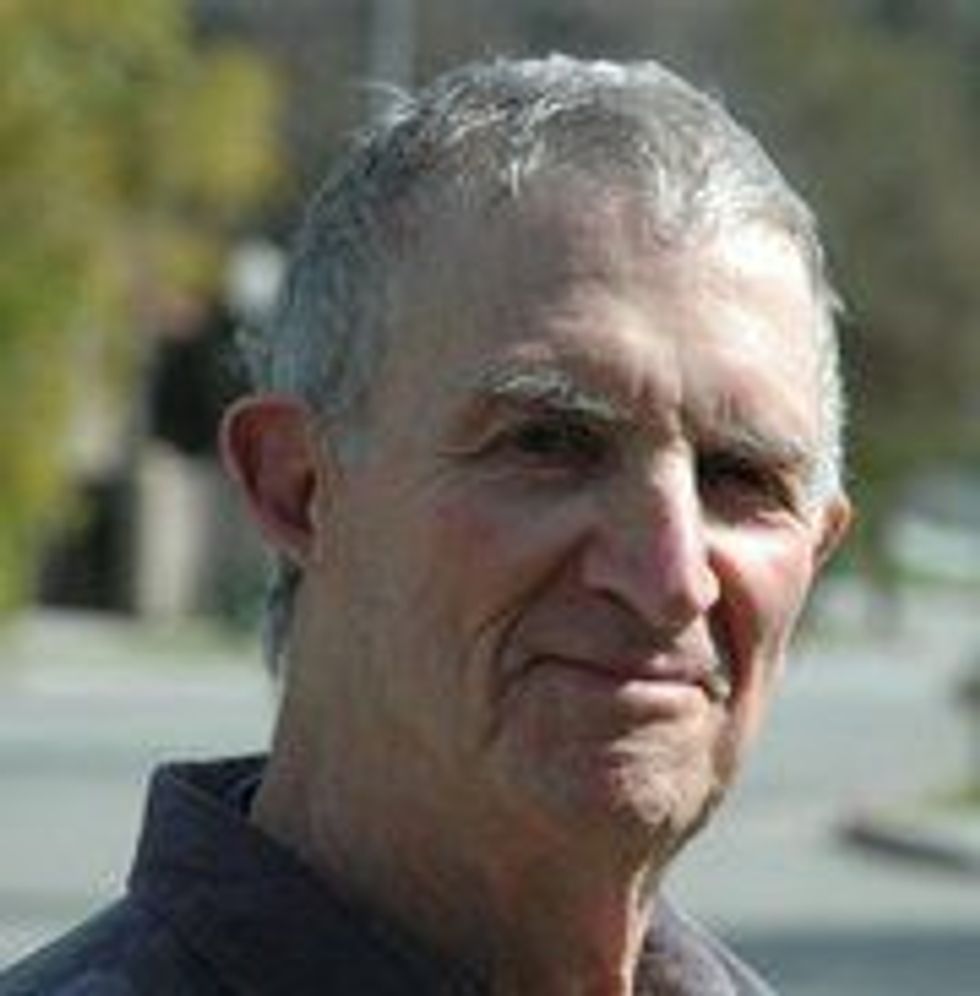Progressives understand that people can disagree with their government and still love their country and its ideals.
This July 4 Americans can celebrate Independence Day by expressing their patriotism around a set of ideas and principles.
To some, patriotism means “my country — right or wrong.” To others, it means loyalty to a set of principles, and thus requires dissent and criticism when those in power violate those standards.
One version of patriotism suggests “Love it or leave it.” The other version embraces “Love it and fix it.”
This is a longstanding debate in American history.
For progressives, dissent and protest are patriotic. This year, they can express their patriotism by walking a picket line with striking hotel workers, writers, actors, Starbucks baristas, and journalists at 50 Gannett newspapers. Bring the flag. It is your flag, too.
Former President George W. Bush questioned the patriotism of anyone who challenged his war on terrorism. In his 2001 State of the Union address, for example, Bush famously claimed, “You’re either with us, or with the terrorists.” He introduced the Patriot Act to codify this view, giving the government new powers to suppress dissent.
In contrast, President Barack Obama said: “I have no doubt that, in the face of impossible odds, people who love their country can change it.” He observed that, “Loving your country shouldn’t just mean watching fireworks on the Fourth of July. Loving your country must mean accepting your responsibility to do your part to change it. If you do, your life will be richer, our country will be stronger.”
Obama was echoing the words of Rev. Martin Luther King, who declared, in a speech during the Montgomery bus boycott in 1955, “the great glory of American democracy is the right to protest for right.”
President Joe Biden has said that “we’re all part of a chain of patriots” who fought for democracy, freedom, fair play, peace, security, and opportunity. Patriots, he explained, seek “the right to equal justice under the law, the right to vote and have that vote counted, the right to breathe clean air, drink clean water, and know that our children and grandchildren will be safe on this planet for generations to come, the right to rise in the world as far as your God-given talent can take you, unlimited by barriers of privilege or power.”
That is so different from Donald Trump’s insistence that patriotism is about fealty to one man and his government.
As president, Trump would often fetishize the American flag, other American symbols, and the concept of patriotism broadly while displaying a shallow, ahistorical, and sometimes downright bizarre understanding of what they meant. At a speech to the American Legion in Cincinnati, Trump said, “We want young Americans to recite the Pledge of Allegiance.” He promised the war veterans that he would work “to strengthen respect for our flag.” He pledged that: “We will be united by our common culture, values and principles, becoming one American nation, one country under one constitution saluting one American flag — and always saluting it — the flag all of you helped to protect and preserve, that flag deserves respect.”
Once, at a campaign rally in Tampa, as his cult followers chanted “build that wall,” Trump interrupted his speech to give a bear hug to an American flag on the stage behind him — apparently as a way to demonstrate his patriotism.
“We want to make sure that anyone who seeks to join our country, shares our values and has the capacity to love our people,” Trump said at a rally at the Kennedy Center in 2017.
“We all salute the same great American flag,” Trump said in his 2017 inauguration address — a line he has repeated in many speeches since then.
To Trump and his followers, the flag was synonymous with “America First”: deporting undocumented immigrants and caging their children in detention centers, restricting visitors from Muslim countries, withdrawing from the Paris climate accord and other international agreements, and engaging in friendships with likeminded dictators.
To Trump, anyone who disagrees with him is unpatriotic, perhaps even un-American (or even, gasp, a socialist).
Progressives understand that people can disagree with their government and still love their country and its ideals. The flag, as a symbol of the nation, is not owned by the administration in power, but by the people. We battle over what it means, but all Americans — across the political spectrum — have an equal right to claim the flag as their own.
In 1968, in a famous speech against the Vietnam war, Norman Thomas, the aging leader of the Socialist Party, proclaimed, “I come to cleanse the American flag, not burn it.” That is the appropriate way for Americans to express their patriotism and protest the white supremacist, anti-immigrant, and reactionary forces that have recently gripped our country.
Indeed, throughout our history, many American radicals and progressive reformers have proudly asserted their patriotism. To them, America stood for basic democratic values — economic and social equality, mass participation in politics, free speech and civil liberties, elimination of the second-class citizenship of women and racial minorities, a welcome mat for the world’s oppressed people. The reality of corporate power, right-wing xenophobia, and social injustice only fueled progressives’ allegiance to these principles and the struggle to achieve them.
Two of the greatest patriots in American history were Francis Bellamy, the Christian socialist who wrote the Pledge of Allegiance, and Katherine Lee Bates, the poet who penned America the Beautiful, who was not only a socialist but also a lesbian?
Bellamy, a Baptist minister who lived from 1855 to 1931, wrote the Pledge of Allegiance in 1892 to express his outrage at the nation’s widening economic divide. He had been ousted from his Boston church for his sermons depicting Jesus as a socialist, and for his work among the poor in the Boston slums.
It was the Gilded Age, an era marked by major political, economic, and social conflicts. Progressive reformers were outraged by the widening gap between rich and poor, and the behavior of corporate robber barons who were exploiting workers, gouging consumers, and corrupting politics with their money. Workers were organizing unions. Farmers were joining forces in the so-called Populist movement to rein in the power of banks, railroads and utility companies. Reformers fought for child labor laws, against slum housing and in favor of women’s suffrage. Socialists and other leftist radicals were gaining new converts.
In foreign affairs, Americans were battling over the nation’s role in the world. America was beginning to act like an imperial power, justifying its expansion with a combination of white supremacy, manifest destiny and the argument that it was spreading democracy. At the time, nativist groups across the country were pushing for restrictions on immigrants — Catholics, Jews, and Asians — who were cast as polluting Protestant America. In the South, the outcome of the Civil War still inflamed regional passions. Many Southerners, including Civil War veterans, swore allegiance not to the American but to the Confederate flag.
Bellamy, a cousin of Edward Bellamy, author of two bestselling radical books, Looking Backward and Equality, believed that unbridled capitalism, materialism, and individualism betrayed America’s promise. He hoped that the Pledge of Allegiance would promote a different moral vision to counter the rampant greed he argued was undermining the nation.
When composing the Pledge, Bellamy had initially intended to use the phrase “liberty, fraternity, and equality,” but concluded that the radical rhetoric of the French Revolution wouldn’t sit well with many Americans. So he coined the phrase, “one nation, indivisible, with liberty and justice for all,” as a means to express his more egalitarian vision of America, and a secular patriotism aimed at helping unite a divided nation.
Bellamy wrote the Pledge of Allegiance for Youth’s Companion, a magazine for young people published in Boston with a circulation of about 500,000. A few years earlier, the magazine had sponsored a largely successful campaign to sell American flags to public schools. In 1891, the magazine hired Bellamy to organize a public relations campaign to celebrate the 400th anniversary of Christopher Columbus’s discovery of America by promoting use of the flag in public schools.
Bellamy gained the support of the National Education Association, along with President Benjamin Harrison and Congress, for a national ritual observance in the schools, and he wrote the Pledge of Allegiance as part of the program’s flag salute ceremony.
Bellamy thought such an event would be a powerful expression on behalf of free public education. Moreover, he wanted all the schoolchildren of America to recite the pledge at the same moment. He hoped the pledge would promote a moral vision to counter the individualism embodied in capitalism and expressed in the climate of the Gilded Age.
In 1923, over the objections of the aging Bellamy, the National Flag Conference, led by the American Legion and the Daughters of the American Revolution, changed the opening, “I pledge allegiance to my flag,” to “I pledge allegiance to the flag of the United States of America.” Ostensibly, it was revised to make sure that immigrant children — who might have thought that “my flag” referred to their native countries — knew that they were pledging allegiance to the American flag.
In 1954, at the height of the Cold War, when many political leaders believed that the nation was threatened by godless communism — the Knights of Columbus led a successful campaign to lobby Congress to add the words “under God.”
A year after Bellamy composed the Pledge, the same social conditions and political sympathies inspired Bates to write the poem America the Beautiful, which was later set to music written by Samuel Ward, the organist at Grace Episcopal Church in Newark, New Jersey. (The Mormon Tabernacle Choir sang their song at Trump’s inauguration.)
Like Bellamy, Bates was a Christian socialist. A well-respected poet and professor of English at Wellesley College, Bates (1859-1929) was also a lesbian who lived with and was devoted to her colleague Katharine Coman, an economics professor. They were both part of progressive circles in the Boston area that supported labor unions, advocated for immigrants, and fought for women’s suffrage. She was an ardent foe of American imperialism.
America the Beautiful was initially published in 1895 to commemorate the Fourth of July. The poem is usually heard as an unalloyed paean to American virtue. But a close reading of her words makes it clear that she had something more in mind. She wrote:
America! America!
God shed His grace on thee
Till selfish gain no longer stain,
The banner of the free!
Bates hoped that a progressive movement, inspired by both religious and secular beliefs, could overcome the Gilded Age’s greed.
Most Americans are unaware that much of our patriotic culture — including many of the leading symbols and songs — was created by people with decidedly progressive sympathies.
Consider the lines inscribed on the Statue of Liberty: “Give me your tired, your poor/Your huddled masses yearning to breathe free.” Emma Lazarus was a poet of considerable reputation in her day, who was a strong supporter of Henry George and his “socialistic” single-tax program, and a friend of William Morris, a leading British socialist. Her welcome to the “wretched refuse” of the earth, written in 1883, was an effort to project an inclusive and egalitarian definition of the American Dream.
In the Depression years and during World War II, the fusion of populist, egalitarian and anti-racist values with patriotic expression reached full flower.
Langston Hughes’ poem, Let America Be America Again, written in 1936, contrasted the nation’s promise with its mistreatment of his fellow African-Americans, the poor, Native Americans, workers, farmers and immigrants:
O, let my land be a land where Liberty
Is crowned with no false patriotic wreath
But opportunity is real, and life is free
Equality is in the air we breathe.
In 1939, composer Earl Robinson teamed with lyricist John La Touche to write Ballad for Americans, which was performed on the CBS radio network by Paul Robeson, accompanied by chorus and orchestra. This 11-minute cantata provided a musical review of American history, depicted as a struggle between the “nobody who’s everybody” and an elite that fails to understand the real, democratic essence of America.
Robeson, at the time one of the best-known performers on the world stage, became, through this work, a voice of America.
Broadcasts and recordings of Ballad for Americans (by Bing Crosby as well as Robeson) were immensely popular. In the summer of 1940, it was performed at the national conventions of both the Republican and Communist parties. The work soon became a staple in school choral performances, but it was literally ripped out of many public school songbooks after Robinson and Robeson were identified with the radical left and blacklisted during the McCarthy period. Since then, however, Ballad for Americans has been periodically revived, notably during the bicentennial celebration in 1976, when a number of pop and country singers performed it in concerts and on TV.
Aaron Copland’s Fanfare for the Common Man and A Lincoln Portrait, both written in 1942, are now patriotic musical standards, regularly performed at major civic events. Few Americans know that Copland was a member of a radical composers’ group.
Many Americans consider Woody Guthrie’s song This Land Is Your Land, penned in 1940, to be our unofficial national anthem. Guthrie, a radical, was inspired to write the song as an answer to Irving Berlin’s popular God Bless America, which he thought failed to recognize that it was the “people” to whom America belonged.
The words to This Land Is Your Land reflect Guthrie’s belief that patriotism and support for the underdog were interconnected. In this song, Guthrie celebrated America’s natural beauty and bounty, but criticized the country for its failure to share its riches. This is reflected in the song’s last and least-known verse, which Pete Seeger and Bruce Springsteen included when they performed the song in January 2009 at a pre-inaugural concert in front of the Lincoln Memorial, with President-elect Obama in the audience:
One bright sunny morning;
In the shadow of the steeple;
By the relief office;
I saw my people.
As they stood hungry;
I stood there wondering;
If this land was made for you and me.
During the 1960s, American progressives continued to seek ways to fuse their love of country with their opposition to the government’s policies. The March on Washington in 1963 gathered at the Lincoln Memorial, where Martin Luther King Jr. famously quoted the words to My Country ‘Tis of Thee, repeating the phrase “Let freedom ring” 11 times.
Phil Ochs, then part of a new generation of politically conscious singer-songwriters who emerged during the 1960s, wrote an anthem in the Guthrie vein, The Power and the Glory, that coupled love of country with a strong plea for justice and equality. The words to the chorus echo the sentiments of the anti-Vietnam War movement:
Here is a land full of power and glory;
Beauty that words cannot recall;
Oh her power shall rest on the strength of her freedom;
Her glory shall rest on us all.
One of its stanzas updated Guthrie’s combination of outrage and patriotism:
Yet she’s only as rich as the poorest of her poor;
Only as free as the padlocked prison door;
Only as strong as our love for this land;
Only as tall as we stand.
This song later became part of the repertoire of the U.S. Army band.
In recent decades, Bruce Springsteen has most closely followed in the Guthrie tradition. From Born in the USA to his songs about Tom Joad (the militant protagonist in John Steinbeck’s The Grapes of Wrath), to his anthem about the 9/11 tragedy (Empty Sky), to his album Wrecking Ball (including its opening song, We Take Care of Our Own), Springsteen has championed the downtrodden while challenging America to live up to its ideals.
Steve Van Zandt is best known as the guitarist with Springsteen’s E Street Band and for his role as Silvio Dante, Tony Soprano’s sidekick on the TV show, The Sopranos. But his most enduring legacy should be his love song about America, I Am a Patriot, including these lyrics:
I am a patriot, and I love my country;
Because my country is all I know.
Wanna be with my family;
People who understand me;
I got no place else to go.
And I ain’t no communist,
And I ain’t no socialist,
And I ain’t no capitalist,
And I ain’t no imperialist,
And I ain’t no Democrat,
Sure ain’t no Republican either,
I only know one party,
And that is freedom.
Since the American Revolution, each generation of progressives has expressed an American patriotism rooted in democratic values that challenged jingoism and “my country — right or wrong” thinking. They rejected blind nationalism, militaristic drum beating, and sheep-like conformism.
Throughout the United States’ history, they have viewed their movements — abolition of slavery, farmers’ populism, women’s suffrage, workers’ rights, civil rights, environmentalism, gay rights, and others — as profoundly patriotic. They believed that America’s core claims — fairness, equality, freedom, justice — were their own.
America now confronts a new version of the Gilded Age, brought upon by Wall Street greed and corporate malfeasance. Americans are upset by the unbridled selfishness and political influence-peddling demonstrated by banks, oil companies, drug companies, insurance companies, and other large corporations. They are angry at the growing power of American-based global firms who show no loyalty to their country, outsource jobs to low-wage countries, avoid paying taxes, and pollute the environment.
As president and now as an ex-president, Trump tapped into a new wave of hate and bigotry. Trump may want to require American schoolchildren to recite the Pledge of Allegiance, but his vision of America is a far cry from Bellamy’s – or any progressive who fights to push the country to live up to its ideals.
Throughout American history, progressive movement had won major victories and also experienced setbacks. When those setbacks occur, it is understandable that people sometimes lose hope, and even give up the fight. But our history also teaches us that we can’t give up, because we must keep the struggle alive for a new generation.
One lesson of our history is that America’s corporate ruling class is not invincible, that racist and reactionary movements can be defeated, that public opinion can change, and that electing progressives to office helps thwart right-wing assaults on our democracy. It is possible to imagine a better world.
But it doesn’t happen overnight. The socialist writer and organizer Michael Harrington used to say that activists for justice had to be long-distance runners. But we prefer the metaphor of a relay race. Each generation does what it can to change society, and then hands the baton to the next generation to continue the struggle for justice.
The recent rulings by the Republican-dominated Supreme Court against abortion, affirmative action, student loan forgiveness, voting rights, and other issues – and ability of Republicans in Congress to thwart progress on many key issues - are surely disheartening. It is important to see these setbacks as part of a reactionary backlash against early progressive victories. So, too, the growing efforts by white nationalists and religious zealots to ban the teaching about Black and LGBTQ lives and history in our public schools are backlashes against previous civil rights and LGBTQ victories. They reactionaries can try to push back, but they can’t erase or nullify those victories.
These forces are waging a rear-guard effort to turn back the clock on the victories on the labor, civil rights, feminist, LGBTQ, and environmental justice movements since the 1960s. These movements are still alive. Occupy Wall Street changed how Americans’ thought about corporate power and wealth inequality. Recent public opinion polls show that the vast majority of Americans – even a majority of Republicans – think that big corporations and the super-rich don’t pay enough taxes and have too much political influence. Black Lives Matter woke many Americans up to the reality of police abuse and other forms of systemic racism. The Dreamers immigrant rights movement, the Green New Deal movement, the #MeToo movement, the Fight for $15 campaign, the growing upsurge of union organizing, the burgeoning tenants rights movement in cities across the country, and the persistent battle for Medicare for All, and the growing number of progressives and democratic socialists elected to office in Congress, and in municipal and state government, are all part of a new wave of activism around progressive ideals.
They all embody the Pledge of Allegiance’s idea of “liberty and justice for all.” It reflects America’s tradition of progressive patriotism. It recognizes that conservatives don’t have a monopoly on Old Glory.
Happy July 4.
From Your Site Articles
Related Articles Around the Web















